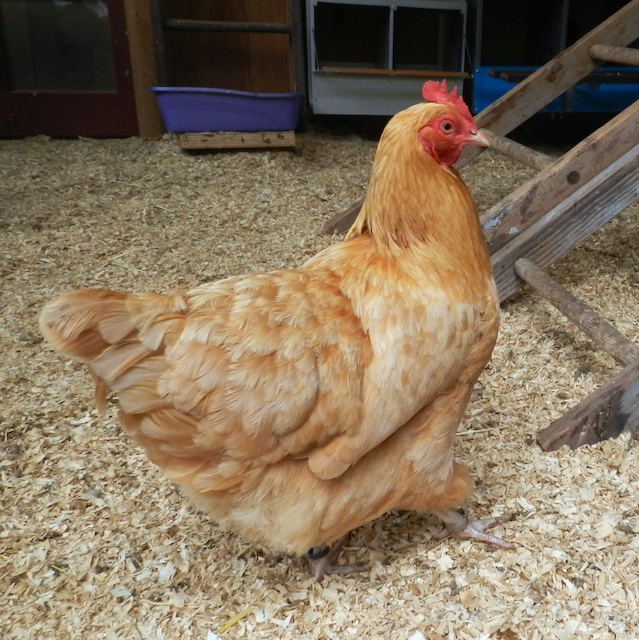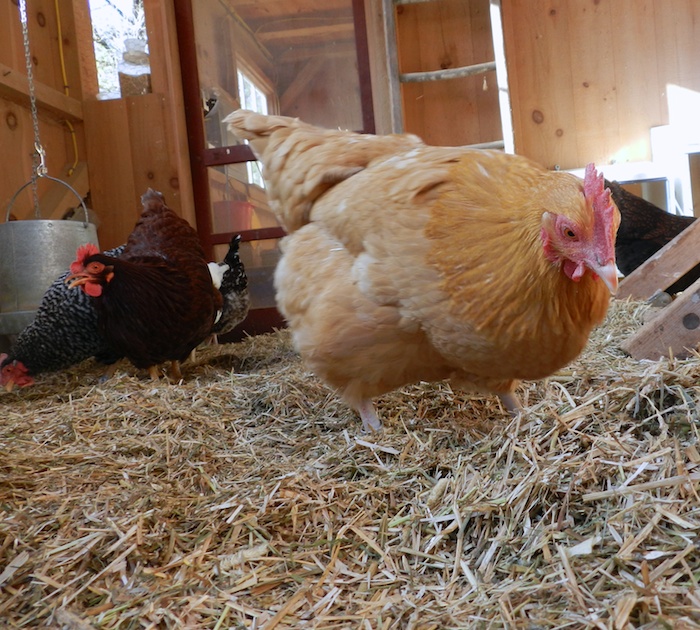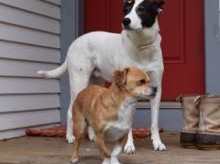The floor of your chicken coop might be dirt, wood or concrete. On top of that goes bedding.To pick out the right bedding you have to understand what it does, so first I’ll explain its purpose, and then list some of the options.
Birds don’t pee – everything comes out in one plop, and that pile is more than 75% liquid. As the manure breaks down it gives off caustic and smelly ammonia fumes, and water evaporating from the manure makes the air damp. Healthy poo is an almost solid pile that is streaked with white. But once a day, a hen leaves a runny brown mess which is expelled from her cecal pouch. This is perfectly normal, although rather nasty. It’s not something easily cleaned off of a bare floor. Chickens produce manure all day and all night long. In fact, they poop so much while sleeping that there will be piles of it under the roosts in the morning. A hen is not like a rabbit, which is a tidy animal that likes to have its bathroom area in one place away from her den. Chickens poop everywhere, and they cannot be trained to do otherwise. Each hen will defecate about four ounces a day. So, if you’re going to have chickens, you need to plan for how to keep the coop clean and how to handle that manure. The first step in manure management is to have bedding inside of the coop.
I want a coop that I can walk into without saying ewww! The right bedding on the coop’s floor will function to dry up the manure, and keep it as whole as possible, until you, the “farmer” skips it out into a muck tub and remove it to the compost pile.
The right bedding can also keep the hens occupied. They need to scratch, and hard floors cannot satisfy this ingrained behavior. Bare earth doesn’t work either. It stays damp, and the hens will make big craters. Some people tout the use of a deep litter system for their coops, which certainly gives the chickens a thick layer of bedding to scratch in. However, for many reasons, this is not a good choice for most backyard flocks. I write about that here.
Chicken Coop Bedding Options:
Pine Shavings: Wood shavings are excellent bedding; bags of pine shavings are widely available at feed stores and are not too expensive. Shavings are absorbent, and it’s easy to use a fine-tined pitchfork to sift through them and clean up manure. Some people have access to the leavings from a friend’s woodworking shop. It’s great to get free material, but make sure that there are no metal bits (chickens will down anything sparkly), that it’s not dusty, and that it’s sized so that the bedding is absorbent (big chunks of wood won’t do!) Sawdust is not good bedding because your active chickens will kick up a fine dust and that will cause respiratory issues. Also, be aware that not all types of wood makes for good bedding. Cedar and oak can be caustic, and black walnut is very dangerous for some animals.
Hay and Straw: These two are not the same. Hay is made of green, tall, grass that has been dried and baled. The tough yellow stalks left over from harvesting grains like wheat makes up straw. Straw, like hay, is sold in large rectangular bales. Both have drawbacks as coop bedding. One serious issue is that chickens can get impacted crops from trying to eat them. Also, both are poor absorbers of moisture and will mold rather than dry out. Additionally, it is difficult to clean manure out of a coop layered with hay or straw without removing all of the bedding, too. Years ago, farmers had chaffing machines, which chopped hay and straw into small bits. Although not as absorbent as wood shavings, chaff is acceptable bedding. There is a new product for backyard flocks that combines chaff with a naturally absorbent mineral. It’s more expensive than pine shavings, but the chickens love scratching in it, and the coop stays very dry. I’ve written about it here.
Other Plant-based Bedding: There are all sorts of things available on a regional basis – peanut hulls, pine needles, and dried leaves to name a few. Although they are not absorbent, if you have enough, and they are free, and if you remove and replace the bedding weekly, then they are possible options. You’ll know if they’re working okay if the air in your coop smells fresh and feels dry.
Sand: I do not like this option. Although it is easy to clean, sand holds moisture. I’ve heard from enough people who have had respiratory diseases and frostbite due to sand flooring to caution against its use. Also if your coop has a sand or dirt floor, rats and predators can easily burrow their way into your coop. I always like to see a solid floor in a coop. Personally, I prefer concrete, but wood floors are also a deterrent to vermin.
To tell if you’ve chosen the right bedding, and that you’re keeping it dry and refreshed, stand in the coop (or put your head in if you have a small henhouse.) Breathe the air. If you aren’t comfortable – if your eyes water, if you cough from dust, if it feels damp, then your hens aren’t comfortable either. If, though, it’s so nice in there that you want to pull up a stool and spend time with your chickens, then the bedding is just right.



As usual, you have provided a well rounded, common sense approach to an important topic. We started with straw because we have it in abundance but you are right….it was messy, hard to keep clean and held moisture. We now use pine bedding and while we don’t actually use the deep litter methods per se, we do have about 4-6 inches of bedding that is dry, smells good and having only three hens presently, scoop out the poop daily.The finer stuff underneath is perfectly dry and has no odour. I enjoy spending time in the coop! Thanks again Terry. Oh…we were at -29 celcius this morning….with a heat lamp carefully put in place with extra safety precautions, the girls suffered no frostbite. At about -17 though without the lamp, they do get frostbitten combs.
You use your heat lamp thoughtfully and after careful observation. You know your coop and your hens. You’re right to use it!
For those who have poop boards ground corn cobs work great on the board in the winter. Without the corn cob the poo freezes to the board and is difficult to remove. This is a case of a little goes a long way. I don’t put a complete “layer” on the board just enough so that a few pieces are under each plop of poop. Removal is then a breeze.
Great tip, Ken. For those who don’t know, poop boards are boards under the roosts that catch the nighttime manure. It keeps the poop from going into the bedding and can reduce clean up of the flooring. It does freeze to the board in winter. Ground corn cobs must be a regional thing, Ken. We don’t get them here. In my big barn, the barn’s beams act as a small poop board. If I don’t scrape it off daily in the summer, it becomes a hatching place for fly larvae. So, as always, whatever the system, keep it clean!
Yes if you have a poop board a daily scrap in the warmer months is almost a necessity. I use a dust pan, bucket and off to the compost container.
The poop board is the most convenient for me. It takes me all of two minutes to finish the chore in the morning.
I was just telling Rob, that I was thinking about going to sand… now I’m not!
Terry I consider you my teacher. I wish you lived next door! You gave me great advice last summer and I’ve been following you ever since. Thank you so much! I would like to comment on the use of sand. I am a neat freak and will never change. We have five hens and I do not want any more than that as I will never be able to keep up with poop clean up. Believe it or not, I pick up their poop three times a day. I love my chickens and don’t really consider it a chore as I get to visit with them at the same time. We have an 8×10 shed with a wood floor. On top of that is linoleum. On top of that is a thin layer of contractor’s sand. Just enough to be able to scoop up poop easily and keep it from the linoleum. The poop sits on top of the sand, there is no lost food, no moisture, no smell, no need for grit. I know there is no moisture because during these cold temps in Connecticut I have no moisture or frost on the inside of my windows. It probably means we have the ventilation right as well. We have three large windows and a 15-lite glass door. I think many people who use sand use too much, don’t clean and probably use play sand instead of contractors sand, which contains silica and known to cause respiratory problems.
Thank you, Mary, for the kind words. Any bedding would work if you pick up 3 times a day :) It sounds like you have figured out exactly what works for you. You have some lucky hens to be under your care.
I just wanted to give you an update on the bedding issue. I used sand up until a couple of weeks ago. I am a big fan of sand. We have a wooden coop floor with mining belt nailed on top of that. The mining belt has little wires weaved throughout the belt.(Like tires). We would scoop the sand everyday and it was always neat and tidy. However, the smell was horrible. Even though we scooped everyday, there was always this strong chicken poo odor. I hated it. I thought well, there’s not any poo on the floor so it must be the usual thing. I thought the chickens produced it, so they must be use to it. Then I thought maybe the wood used to build the coop has absorbed the odor. No matter what, that smell was strong and would not go away. We often would lock the hens out and open the door to get fresh air in the coop. That didn’t help. The girls didn’t spend much time in the coop other than when we locked them in at night. (not when it was pouring down the rain or very cold temps, even). They would stay in the run. So, I finally broke down and gave up the sand because it’s winter and at your suggestion, and got the pine shavings. My girls love it. Within hours that horrible odor was gone. The hens stay in the coop all the time now, especially in bad weather. Not as easy to clean, but the trade off is worth it. We have decided to go all pine shaving in the winter. We will have sand in the summer with a very thin layer of pine shaving for odor control in summer. We have finally found our happy medium. Thanks to your advice.
PS- Great topic. This has been an ongoing issue for us.
Sorry to comment again, but I didn’t know chickens pee and poop at the same time and it all comes out together. I wanted to ask about that for a long time, but hated to show my lack of knowledge of chickens. I was also concerned about the brown jelly like glob that comes out. Made me wonder if the chicken was on the verge of being sick with something. Your posts are so helpful for a peace of mind. Thanks.
You wouldn’t believe how many people think that their chickens are sick when they see the cecal poop! And few people realize that birds don’t pee. If they had to carry that liquid around with them they’d be too heavy to fly. Also why they poop so frequently. Like a balloonist shedding ballast.
The last sentence. If you watch a chicken before they jump up on something they generally defecate before doing so.
I too am grateful for your help in making wise choices in my chicken care. We have been using the pine chips in our hen house since we started with chickens a year and 1/2 ago. I find them very easy to work with….quick clean-up, hand picking the poop out each a.m. into bucket, then refresh with equal amount of chips. I do a complete change of chips every couple of months. The house always smells fresh and looks cozy. I like the look of the koop clean you use but it is not available here yet. We use sand in the outdoor covered run part of our coop and find this also works really well. It also is very easy to keep clean and gives the hens a soft place to land when jumping down from outdoor roosts and a good digging for a dust bath if they are stuck in their run, as they are usually free-ranged during the day. I was tempted to change to sand in their house simply to save a trip to the feed store for the chips. I realize now that it would probably not be the best decision for my birds.
Hi Terry,
I started using Koop Clean after you tested it and I like it so much more than the wood shavings. It’s about 3X more expensive, but it smells so much nicer.
It did freak the girls out when I started using it and the committee met outside the coop that afternoon for a lot of clucking and chirring. Just after dusk on a bitter night — this was last month — I went out to check that they had all adjusted and found my three Wyandotte hens huddled miserably together outside in the run, their wings around each other. I had to carry them inside to their perch and by morning they were happily rooting through the shredded straw.
Terry, I love reading your blogs! Our coop is a converted garden shed with a concrete floor. I layer 2 to 3 inches of small size pine shavings over the concrete which has worked perfectly for years. I love it! I have also found it very easy to clean which I do twice daily. First thing in the morning, I go out to the coop, turn the light on, and I collect the poo under the roosts before my girls jump down in it and into the compost trash can it goes. Then in the afternoon after work, I pick up the hardened piles of poo from the day and add a little fresh shavings to the mix. This routine works and my girls feet and perches stay clean. Plus, no poo on the eggs from dirty feet is a wonderful thing.
Btw, my girls have been laying for 2 weeks now and I got 6 out of 6 yesterday! 4 brown, 1 green, and 1 blue. I was so thrilled! =)
SAND? How about a layer of gravel, then SAND, then pine shaving on top? I have a very big covered coop, 8′ by 16′. It does not get rain. I don’t want to pay to cement or to wood floor it. When I use just gravel, I get way too much gavel in my compost bin. I was thinking about covering the gravel with about 3in of SAND, and then pine shavings on top. Will that work? I have yards and yards of pine shavings, and lots of free gravel and SAND.
Chickens love to scratch down. They dig up big pits to dust bathe in. They’ll stop at the gravel, but they’ll mix the sand and the shavings up very quickly. If the gravel is small enough, they’ll kick that up, too. 3 inches of sand is nothing to a hen’s flying feet. I’d forget the gravel, and go with just the dirt and shavings above. However, a trench filled with pea stones around the coop will help to deter burrowing predators.
If I may add the gravel may lead to bumble foot as well. Jumping down from nest boxes and roosts onto gravel will be rough on the pads of the chickens feet. I provide a ladder for hens to gain access to the roosts. Some of them use to get up there but very few use it to get down, they just jump/fly off the bottom roost of about 30 inches.
Good point, Ken. Even if you think that the gravel is covered by sand and shaving, those chickens will dig it up.
We have a chicken run that gets real muddy. We have a roof over all of it now, but the rain still ends up getting ground wet in many sections of it. One section was covered originally, and that area stays dry and they dust bathe in it, but the rest of the run is wet. We put straw down as our only option to keep down the mud and we clean it out and add new straw every two days, however, they end up eating some and I worry about crop issues. Any recommendations for a runny winter chicken run?
Thank You
Add builders sand to improve drainage and raise up the level of the pen. A gravel-filled ditch around the perimeter also helps. Also, do they have stumps and outside roosts? If they have a way to roost up and out of it, they’ll be thankful.